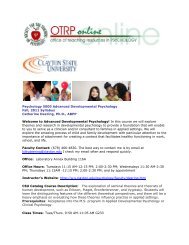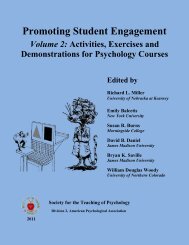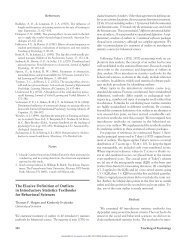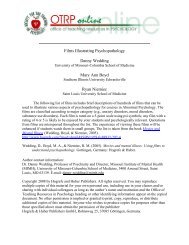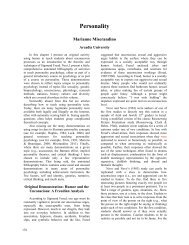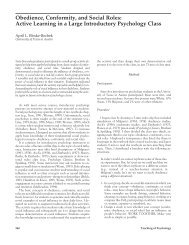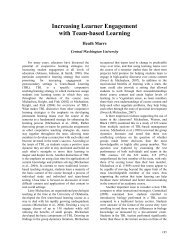INTRODUCTORY PSYCHOLOGY TEACHING PRIMER Early Career ...
INTRODUCTORY PSYCHOLOGY TEACHING PRIMER Early Career ...
INTRODUCTORY PSYCHOLOGY TEACHING PRIMER Early Career ...
You also want an ePaper? Increase the reach of your titles
YUMPU automatically turns print PDFs into web optimized ePapers that Google loves.
video in entirety is 29 minutes but I usually show the first 5-7 mins). Footage from the Milgram<br />
study can be found here: http://www.youtube.com/watch?v=W147ybOdgpE (9 min). Before<br />
showing this clip, ask students by show of hands how many would go all the way to 450 volts.<br />
Rarely one or two students may bravely raise their hand. In the set-up to this video, it is also<br />
important to emphasize that Milgram himself thought only 1% would go all the way. This can also<br />
lead to a discussion of research ethics and the IRBs. (LO 1.2e)<br />
To demonstrate Cognitive Dissonance (a topic students often struggle with), ask students a series<br />
of questions on social issues such as global warming, world hunger, etc. (e.g., Rate your agreement<br />
with these statements from 1 (strongly disagree) to 5 (strongly agree): No one in this country should<br />
go to bed hungry). Then ask if the students engage in any specific behavior regarding these issues<br />
(e.g., Do you personally do anything to help those who are hungry (e.g. donate money/food,<br />
work in soup kitchen)?). Then ask by show of hands how many students had strong attitudinal<br />
statements but responded NO on the second set of questions. Discussion follows about how that<br />
makes us feel when attitudes and behaviors are inconsistent and what we can do about it which<br />
leads into dissonance theory. This activity is quick (10 minutes) but provides relevant application<br />
for students. (LO 4.4)<br />
Stereotypes: When discussing social perception and stereotypes, the classic study by Jane Elliot<br />
can be replicated either in person or by watching a clip from either The Eye of the Storm or A<br />
Class Divided (http://www.pbs.org/wgbh/pages/frontline/shows/divided/). Ask students what<br />
labels we currently categorize by, could this be replicated in modern classrooms, and how can we<br />
minimize the effects of stereotypical assumptions This is often a difficult discussion to have,<br />
encouraging students to be honest and respectful and emphasizing commonalities (e.g., we are all<br />
college students at XYZ) might help alleviate some of the tension. Remember also not to call on<br />
students directly to be a prototype for their social group (e.g., what stereotypes have you<br />
experienced as a Black woman, etc.). (LO 8.4, 8.5)<br />
If looking for a demonstration on a particular topic, the following site has a wealth of activities<br />
organized by topic: http://jfmueller.faculty.noctrl.edu/crow/activities.htm.<br />
RELEVANT TOP ARTICLES<br />
(Annotated Bibliography)<br />
Goldstein, S.B. (1997). The Power of stereotypes: A labeling exercise. Teaching of Psychology,<br />
24, 256-258.<br />
In this article, the author describes a classic activity relevant to stereotypes, the application of<br />
psychological theory, and critical thinking. Students are assigned a trait and then assigned to<br />
work on a group project. Students treat their classmates according to their assigned traits and<br />
observe the effect on their performance. This activity would serve as a nice transition from<br />
discussing self-fulfilling prophecies to stereotypes.<br />
66



